RRG-GAN Restoring Network for Simple Lens Imaging System
Abstract
1. Introduction
- We collect sharp/aberration-degraded datasets by CODE V (https://www.synopsys.com/optical-solutions/codev.html, accessed on 11 May 2021) simulation and manual registering, which will be publicly released on Github for further researches (https://github.com/wuzeping1893/RRG-GAN-single-convex-lens, accessed on 11 May 2021). To the best of our knowledge, this is the first dataset for the single-convex-lens computational imaging field.
- We propose the application of deep-learning-only-based methods for image denoising and deblurring to the special case of single-lens camera images restoring, in contrast with optimization-based methods with great improvement in efficiency and efficacy.
- By redesigning the generator network, the proposed RRG-GAN network includes the dual attention module, selective kernel network module, and residual resizing module. It has better multi-scale feature extraction and fusion ability, which makes the network have better recovery effect.
2. Related Work
2.1. Single-Lens Imaging System
2.2. Motion Deblurring Algorithms
2.3. Motivation of This Paper
3. Methodology
3.1. Hardware Implementation of Single-Convex-Lens Imaging System
3.1.1. Self-Made Optical Lens
3.1.2. Aberration Analysis and Imaging Model
3.2. Proposed Restoring Method
3.2.1. Network Architecture
3.2.2. Discriminator Network: Double-Scale Discriminator Network
3.2.3. Generator Network: RRG-Net
4. Experiments and Results
4.1. Preparation of Dataset Based on CODE V Simulation Datasets
4.2. Algorithm Evaluation Based on CODE V Simulation Dataset
4.3. Apllication in Real Scene
4.3.1. The Reason of Constructing Manual Registering Dataset
4.3.2. The Constructure of Manual Registering Datasets
4.3.3. Algorithm Evaluation Based on Manual Registering Datasets
4.4. Imaging Effect Comparison with SLR Camera Lens
5. Discussion
5.1. Improvement Analysis
5.1.1. Efficiency Improvement over Traditional Methods
5.1.2. Effect Improvement over Deep Learning Methods
5.2. Limitations and Deficiencies
5.3. Further Work
6. Conclusions
Author Contributions
Funding
Institutional Review Board Statement
Informed Consent Statement
Data Availability Statement
Acknowledgments
Conflicts of Interest
Abbreviations
| RRG | Recursive Residual Groups |
| GAN | Generative Adversarial Networks |
| CNN | Convolutional Neural Networks |
| RNN | Recurrent Neural Networks |
| CMOS | Complementary Metal Oxide Semiconductor |
| PSF | Point Spread Function |
| MRB | Multi-scale Residual Block |
| MAP | Maximum A Posteriori Approach |
| VEM | Variational Expectation Maximization |
| MTF | Modulation Transfer Function |
| LCD | Liquid Crystal Display |
| SLR | Single-convex-lens Reflex |
References
- Koppal, S.J. A Survey of Computational Photography in the Small: Creating intelligent cameras for the next wave of miniature devices. IEEE Signal Process. Mag. 2016, 33, 16–22. [Google Scholar] [CrossRef]
- Courtier, G.; Lapray, P.-J.; Thomas, J.-B.; Farup, I. Correlations in Joint Spectral and Polarization Imaging. Sensors 2021, 21, 6. [Google Scholar] [CrossRef] [PubMed]
- Cao, J.; Zhou, D.; Zhang, F.; Cui, H.; Zhang, Y.; Hao, Q. A Novel Approach of Parallel Retina-Like Computational Ghost Imaging. Sensors 2020, 20, 7093. [Google Scholar] [CrossRef] [PubMed]
- Schuler, C.J.; Hirsch, M.; Harmeling, S. Non-stationary correction of optical aberrations. In Proceedings of the IEEE International Conference on Computer Vision, Barcelona, Spain, 6–13 November 2011; pp. 659–666. [Google Scholar]
- Heide, F.; Rouf, M.; Hullin, M.B.; Labitzke, B.; Heidrich, W.; Kolb, A. High quality computational imaging through simple lenses. ACM Trans. Graph. 2013, 32, 149. [Google Scholar] [CrossRef]
- Peng, Y.; Sun, Q.; Dun, X.; Wetzstein, G.; Heidrich, W.; Heide, F. Learned large field-of-view imaging with thin-plate optics. ACM Trans. Graph. 2019, 38, 1–14. [Google Scholar] [CrossRef]
- Dowski, E.R.; Cathey, W.T. Extended depth of field through wave-front coding. Appl. Opt. 1995, 34, 1859–1866. [Google Scholar] [CrossRef] [PubMed]
- Peng, Y.; Fu, Q.; Heide, F.; Heidrich, W. The diffractive achromat full spectrum computational imaging with diffractive optics. ACM Trans. Graph. 2016, 35, 31. [Google Scholar] [CrossRef]
- Xu, L.; Zheng, S.; Jia, J. Unnatural l0 sparse representation for natural image deblurring. In Proceedings of the IEEE Conference on Computer Vision and Pattern Recognition, Portland, OR, USA, 25–27 June 2013; pp. 1107–1114. [Google Scholar]
- Fergus, R.; Singh, B.; Hertzmann, A.; Roweis, S.T.; Freeman, W.T. Removing camera shake from a single photograph. ACM Trans. Graph. 2006, 25, 787–794. [Google Scholar] [CrossRef]
- Levin, A.; Weiss, Y.; Durand, F.; Freeman, W.T. Understanding and evaluating blind deconvolution algorithms. In Proceedings of the IEEE Conference on Computer Vision and Pattern Recognition, Miami, FL, USA, 20–25 June 2009; pp. 1964–1971. [Google Scholar]
- Pan, J.; Sun, D.; Pfister, H.; Yang, M.H. Blind Image Deblurring Using Dark Channel Prior. In Proceedings of the IEEE Conference on Computer Vision and Pattern Recognition, Las Vegas, NV, USA, 26 June–1 July 2016; pp. 1628–1636. [Google Scholar]
- Lai, W.S.; Ding, J.J.; Lin, Y.Y.; Chuang, Y.Y. Blur kernel estimation using normalized color-line prior. In Proceedings of the IEEE Conference on Computer Vision and Pattern Recognition, Boston, MA, USA, 8–10 June 2015; pp. 64–72. [Google Scholar]
- Chakrabarti, A. A neural approach to blind motion deblurring. In Proceedings of the European Conference on Computer Vision, Amsterdam, The Netherlands, 8–16 October 2016; pp. 221–235. [Google Scholar]
- Wang, R.; Ma, G.; Qin, Q.; Shi, Q.; Huang, J. Blind UAV Images Deblurring Based on Discriminative Networks. Sensors 2018, 18, 2874. [Google Scholar] [CrossRef] [PubMed]
- Ren, D.; Zhang, K.; Wang, Q.; Hu, Q.; Zuo, W. Neural Blind Deconvolution Using Deep Priors. In Proceedings of the IEEE Conference on Computer Vision and Pattern Recognition, Seattle, WA, USA, 14–19 June 2020; pp. 3338–3347. [Google Scholar]
- Nah, S.; Hyun Kim, T.; Mu Lee, K. Deep Multi-scale Convolutional Neural Network for Dynamic Scene Deblurring. In Proceedings of the IEEE Conference on Computer Vision and Pattern Recognition, Hawaii, HI, USA, 22–25 July 2017; pp. 257–265. [Google Scholar]
- Zhang, J.; Pan, J.; Ren, J.; Song, Y.; Bao, L.; Lau, R.W.; Yang, M.H. Dynamic scene deblurring using spatially variant recurrent neural networks. In Proceedings of the IEEE Conference on Computer Vision and Pattern Recognition, Salt Lake City, UT, USA, 18–22 June 2018; pp. 2521–2529. [Google Scholar]
- Zhou, Q.; Ding, M.; Zhang, X. Image Deblurring Using Multi-Stream Bottom-Top-Bottom Attention Network and Global Information-Based Fusion and Reconstruction Network. Sensors 2020, 20, 3724. [Google Scholar] [CrossRef] [PubMed]
- Kupyn, O.; Martyniuk, T.; Wu, J.; Wang, Z. Deblurgan-v2: Deblurring (orders-of-magnitude) faster and better. In Proceedings of the IEEE International Conference on Computer Vision, Seoul, Korea, 27 October–2 November 2019; pp. 8878–8887. [Google Scholar]
- Vantaggiato, E.; Paladini, E.; Bougourzi, F.; Distante, C.; Hadid, A.; Taleb-Ahmed, A. COVID-19 Recognition Using Ensemble-CNNs in Two New Chest X-ray Databases. Sensors 2021, 21, 1742. [Google Scholar] [CrossRef] [PubMed]
- Garillos-Manliguez, C.A.; Chiang, J.Y. Multimodal Deep Learning and Visible-Light and Hyperspectral Imaging for Fruit Maturity Estimation. Sensors 2021, 21, 1288. [Google Scholar] [CrossRef] [PubMed]
- Goodfellow, I.J.; Pouget-Abadie, J.; Mirza, M.; Xu, B.; Warde-Farley, D.; Ozair, S.; Bengio, Y. Generative Adversarial Nets. In Proceedings of the Neural Information Processing Systems, Montreal, QC, Canada, 8–13 December 2014; pp. 2672–2680. [Google Scholar]
- Chen, J.; Wu, C.; Chen, H.; Cheng, P. Unsupervised Dark-Channel Attention-Guided CycleGAN for Single-Image Dehazing. Sensors 2020, 20, 6000. [Google Scholar] [CrossRef] [PubMed]
- Li, C.; He, K.; Liu, K.; Ma, X. Image Inpainting Using Two-Stage Loss Function and Global and Local Markovian Discriminators. Sensors 2020, 20, 6193. [Google Scholar] [CrossRef] [PubMed]
- Zamir, S.W.; Arora, A.; Khan, S.; Hayat, M.; Khan, F.S.; Yang, M.H.; Shao, L. CycleISP: Real Image Restoration via Improved Data Synthesis. In Proceedings of the IEEE Conference on Computer Vision and Pattern Recognition, Seattle, WA, USA, 14–19 June 2020; pp. 2693–2702. [Google Scholar]
- Isola, P.; Zhu, J.Y.; Zhou, T.; Efros, A.A. Image-to-image translation with conditional adversarial networks. In Proceedings of the IEEE Conference on Computer Vision and Pattern Recognition, Hawaii, HI, USA, 21–26 July 2017; pp. 5967–5976. [Google Scholar]
- Mao, X.; Li, Q.; Xie, H.; Lau, R.Y.; Wang, Z.; Paul Smolley, S. Least squares generative adversarial networks. In Proceedings of the IEEE International Conference on Computer Vision, Venice, Italy, 22–29 October 2017; pp. 2813–2821. [Google Scholar]
- Tai, Y.; Yang, J.; Liu, X. Image Super-Resolution via Deep Recursive Residual Network. In Proceedings of the IEEE Conference on Computer Vision & Pattern Recognition, Hawaii, HI, USA, 21–26 July 2017; pp. 2790–2798. [Google Scholar]
- Zamir, S.W.; Arora, A.; Khan, S.; Hayat, M.; Khan, F.S.; Yang, M.H.; Shao, L. Learning Enriched Features for Real Image Restoration and Enhancement. In Proceedings of the Europeon Conference on Computer Vision, Glasgow, UK, 23–28 August 2020; pp. 492–511. [Google Scholar]
- Woo, S.; Park, J.; Lee, J.Y.; Kweon, I.S. CBAM: Convolutional block attention module. In Proceedings of the European Conference on Computer Vision, Munich, Germany, 8–14 September 2018; pp. 3–19. [Google Scholar]
- Li, X.; Wang, W.; Hu, X.; Yang, J. Selective Kernel Networks. In Proceedings of the IEEE Conference on Computer Vision and Pattern Recognition, Long Beach, CA, USA, 16–20 June 2019; pp. 510–519. [Google Scholar]
- Sim, H.; Kim, M. A Deep Motion Deblurring Network Based on Per-Pixel Adaptive Kernels with Residual Down-Up and Up-Down Modules. In Proceedings of the IEEE/CVF Conference on Computer Vision and Pattern Recognition Workshops (CVPRW), Long Beach, CA, USA, 16–20 June 2019; pp. 2140–2149. [Google Scholar]
- Wang, Z.; Bovik, A.C.; Sheikh, H.R.; Simoncelli, E.P. Image quality assessment: From error visibility to structural similarity. IEEE Trans. Image Process. 2004, 13, 600–612. [Google Scholar] [CrossRef] [PubMed]
- Simonyan, K.; Zisserman, A. Very deep convolutional networks for large-scale image recognition. arXiv 2014, arXiv:1409.1556. [Google Scholar]
- Bychkovsky, V.; Paris, S.; Chan, E.; Durand, F. Learning Photographic Global Tonal Adjustment with a Database of Input/Output Image Pairs. In Proceedings of the IEEE Conference on Computer Vision and Pattern Recognition, Colorado Springs, CO, USA, 20–25 June 2011; pp. 97–104. [Google Scholar]
- Wu, X.; Yang, H.; Liu, B.; Liu, X. Non-Uniform Deblurring for Simple Lenses Imaging System. In Proceedings of the 2020 3rd International Conference on Advanced Electronic Materials, Computers and Software Engineering (AEMCSE), Shenzhen, China, 24–26 April 2020; pp. 274–278. [Google Scholar]
- Chen, C.; Chen, Q.; Xu, J.; Koltun, V. Learning to see in the dark. In Proceedings of the IEEE Conference on Computer Vision and Pattern Recognition, Salt Lake City, UT, USA, 18–23 June 2018; pp. 3291–3300. [Google Scholar]
- Xu, L.; Jia, J. Two-phase kernel estimation for robust motion deblurring. In Proceedings of the European Conference on Computer Vision, Heraklion, Greece, 5–11 September 2010; pp. 157–170. [Google Scholar]
- Pan, J.; Sun, D.; Pfister, H.; Yang, M.H. Deblurring Images via Dark Channel Prior. IEEE Trans. Pattern Anal. Mach. Intell. 2018, 40, 2315–2328. [Google Scholar] [CrossRef] [PubMed]
- Willmott, C.J.; Matsuura, K. On the use of dimensioned measures of error to evaluate the performance of spatial interpolators. Int. J. Geogr. Inf. Sci. 2006, 20, 89–102. [Google Scholar] [CrossRef]
- Conel, J.E.; Hoover, G.; Nolin, A.; Alley, R.; Margolis, J. Emperical Relationships Among SemiArid Landscape Endmembers Using the Spectral Angle Mapper (SAM) Algorithm. In Summaries of the 4nd Annual JPL Airborne Geoscience Workshop, JPL Pub-92-14, AVIRIS Workshop; Jet Propulsion Laboratory: Pasadena, CA, USA, 1992; pp. 150–151. [Google Scholar]
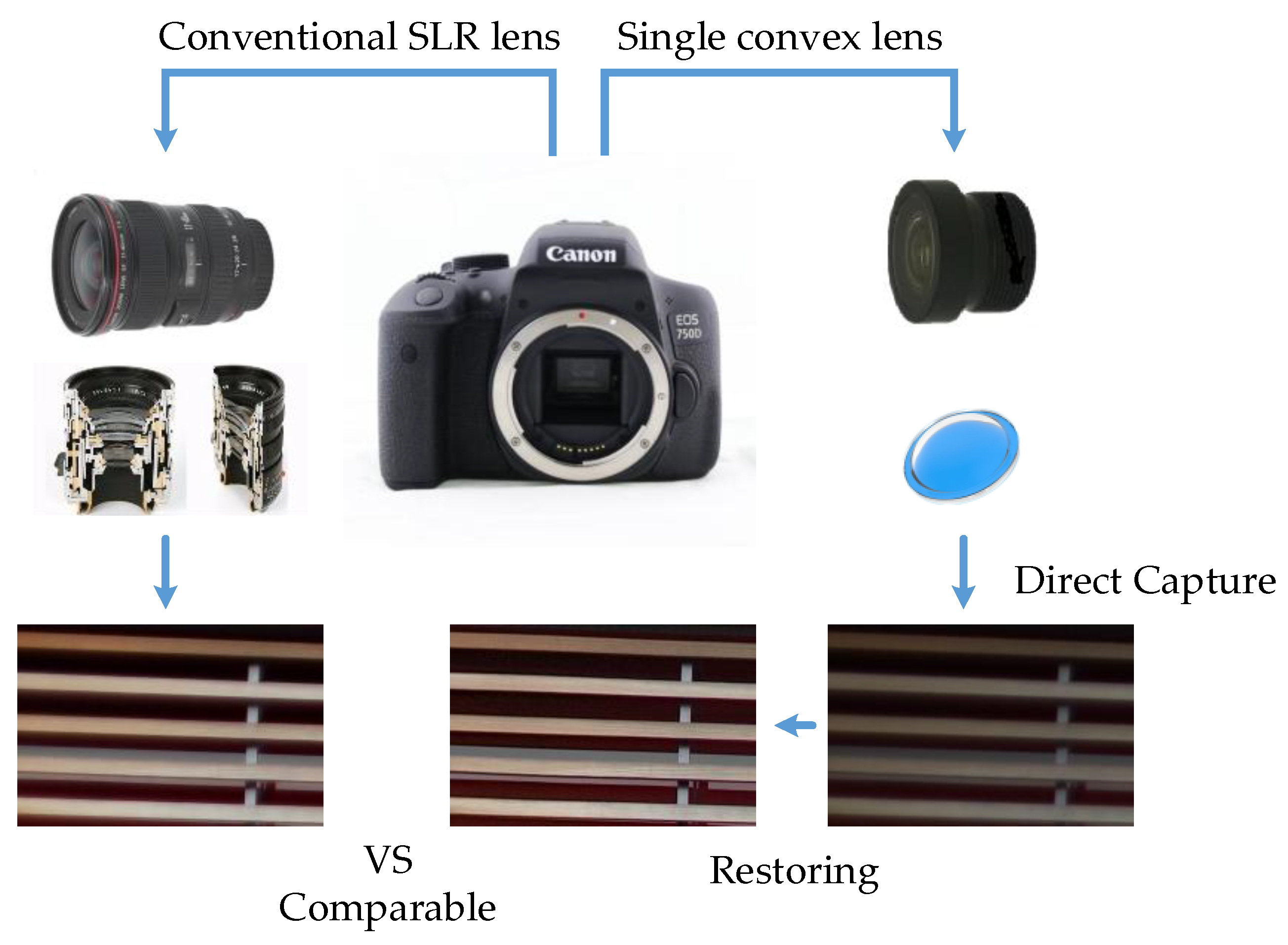

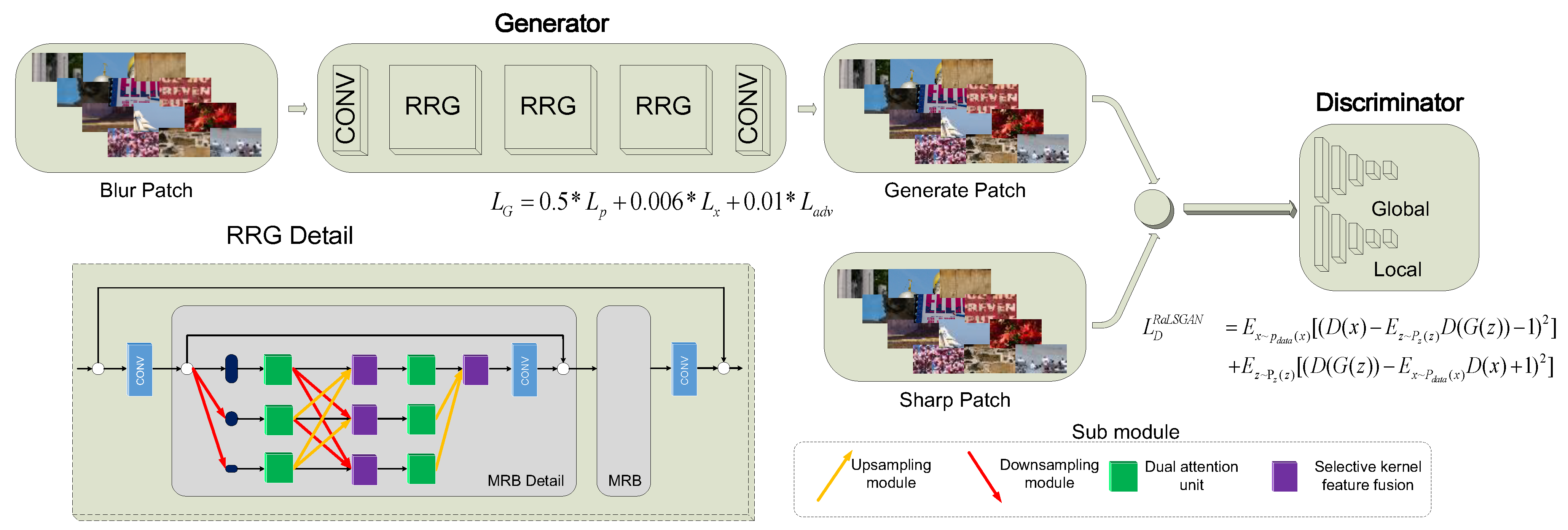


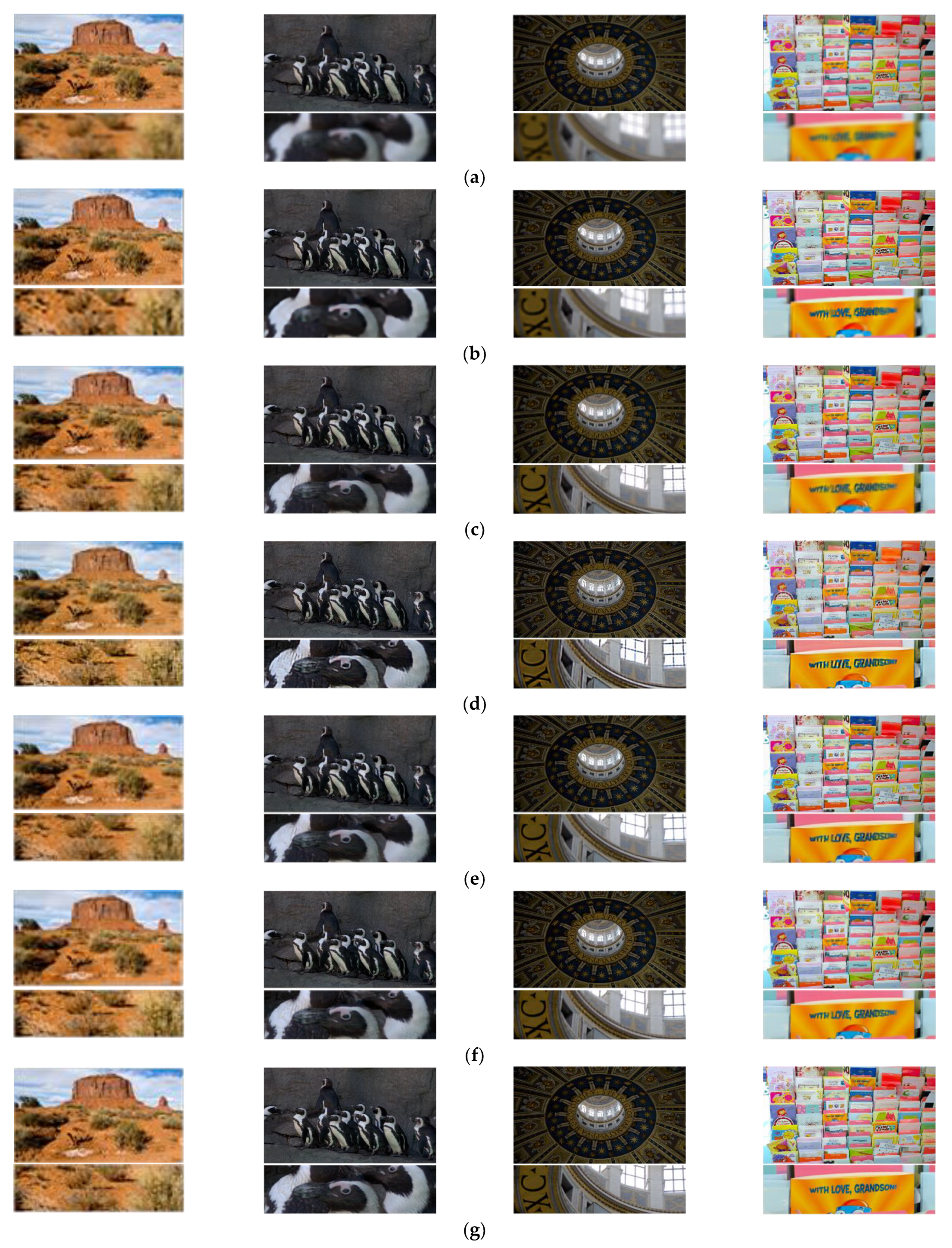
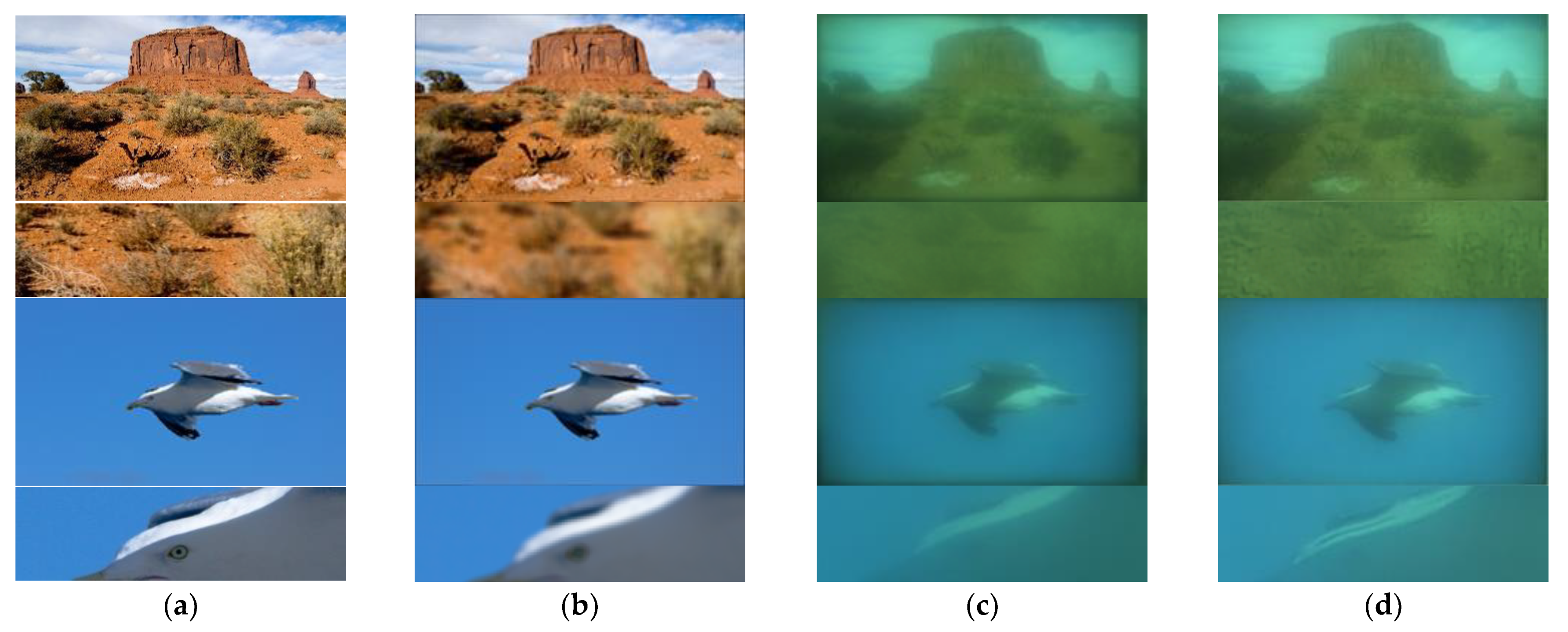

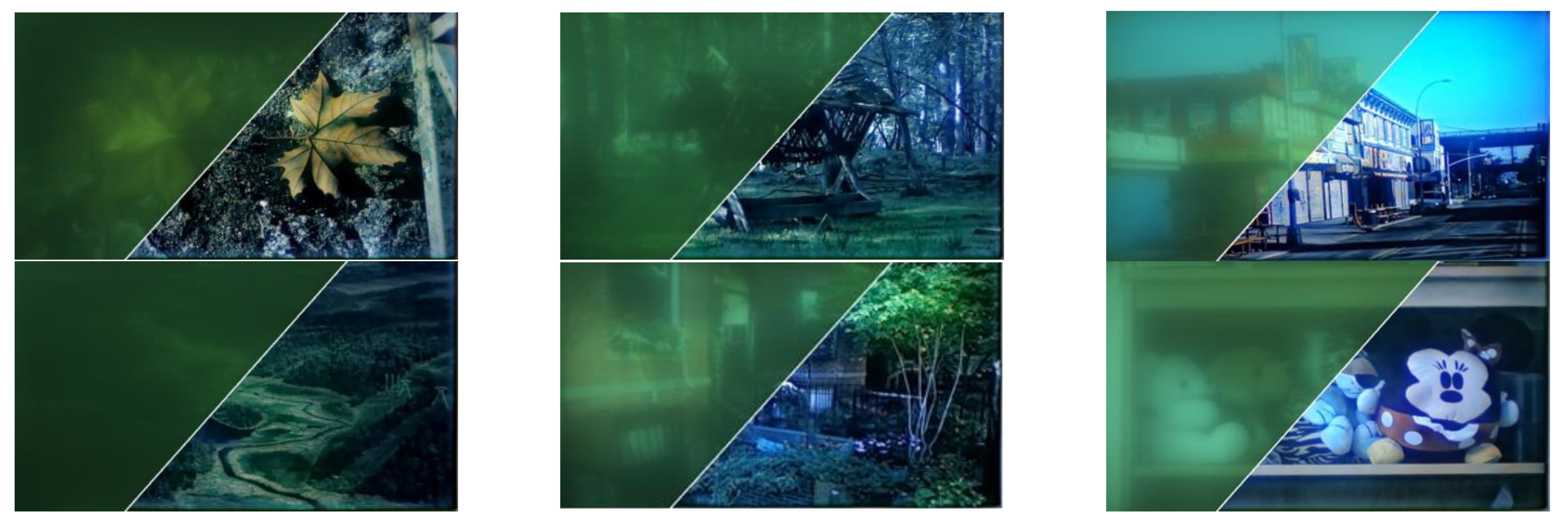


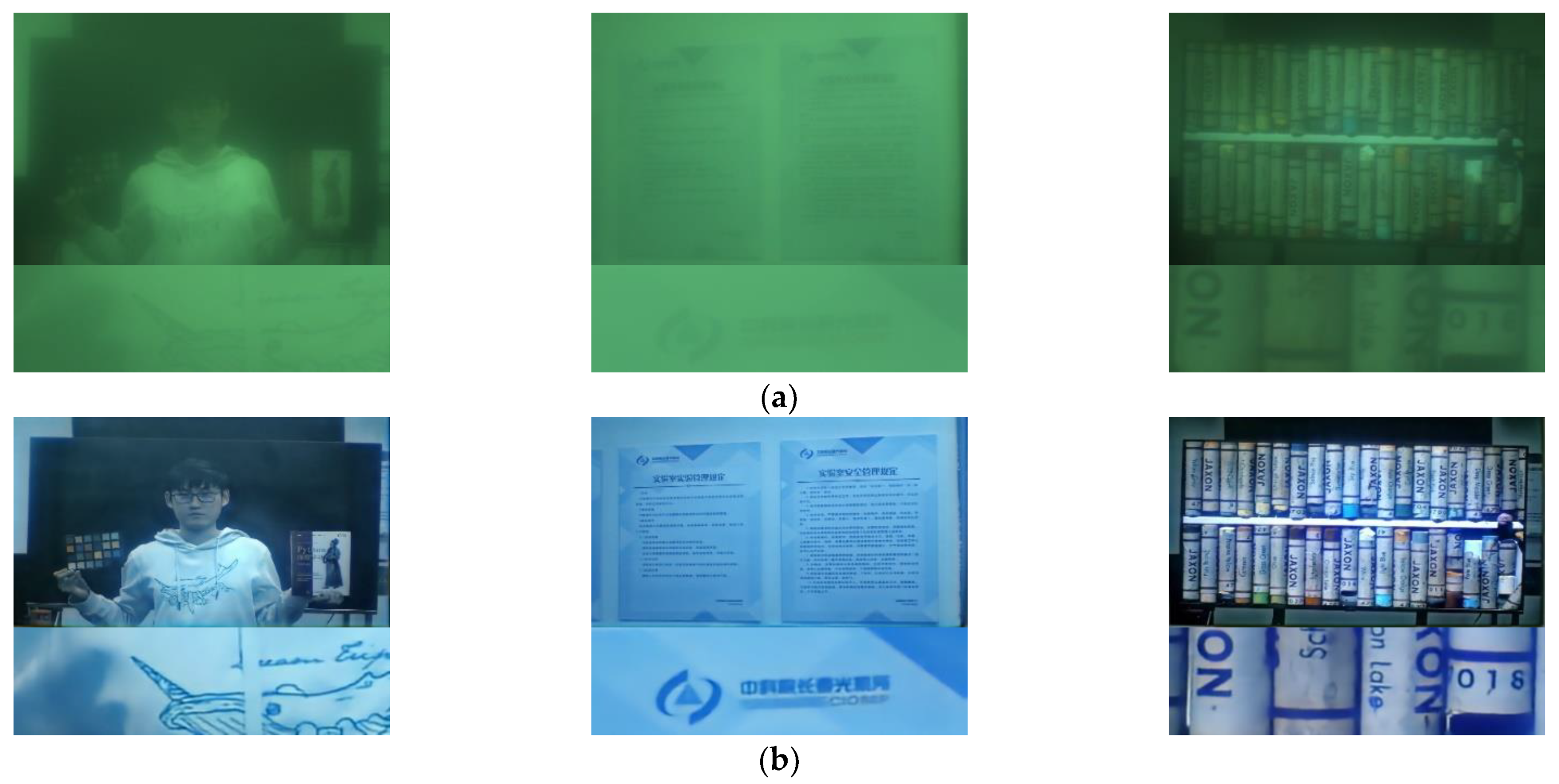

| SSIM | PSNR | RMSE | SAM | |
|---|---|---|---|---|
| Original | 0.6278 | 24.4386 | 16.3857 | 4.5950 |
| Multiscale | 0.6859 | 25.0048 | 15.1276 | 4.7078 |
| Unet | 0.7922 | 28.3427 | 10.6450 | 4.1911 |
| Fov-GAN | 0.7486 | 25.2653 | 14.4563 | 5.6238 |
| Deblur-GAN | 0.7843 | 28.0252 | 10.9077 | 4.5637 |
| RRG-GAN | 0.8650 | 30.4102 | 8.3224 | 3.7855 |
| MultiScale | Unet | FovGAN | DeblurGAN-V2 | RRG-GAN | |
|---|---|---|---|---|---|
| Runtime | 25 min | 0.489 s | 0.714 s | 2.677 s | 2.738 s |
| Para size | / | 363.701 MB | 83.852 MB | 238.982 MB | 31.494 MB |
Publisher’s Note: MDPI stays neutral with regard to jurisdictional claims in published maps and institutional affiliations. |
© 2021 by the authors. Licensee MDPI, Basel, Switzerland. This article is an open access article distributed under the terms and conditions of the Creative Commons Attribution (CC BY) license (http://creativecommons.org/licenses/by/4.0/).
Share and Cite
Wu, X.; Li, J.; Zhou, G.; Lü, B.; Li, Q.; Yang, H. RRG-GAN Restoring Network for Simple Lens Imaging System. Sensors 2021, 21, 3317. https://doi.org/10.3390/s21103317
Wu X, Li J, Zhou G, Lü B, Li Q, Yang H. RRG-GAN Restoring Network for Simple Lens Imaging System. Sensors. 2021; 21(10):3317. https://doi.org/10.3390/s21103317
Chicago/Turabian StyleWu, Xiaotian, Jiongcheng Li, Guanxing Zhou, Bo Lü, Qingqing Li, and Hang Yang. 2021. "RRG-GAN Restoring Network for Simple Lens Imaging System" Sensors 21, no. 10: 3317. https://doi.org/10.3390/s21103317
APA StyleWu, X., Li, J., Zhou, G., Lü, B., Li, Q., & Yang, H. (2021). RRG-GAN Restoring Network for Simple Lens Imaging System. Sensors, 21(10), 3317. https://doi.org/10.3390/s21103317







